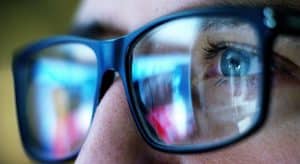A wandering eye is a type of eye condition known as strabismus or tropia, and it may be caused by damage to the retina or muscles that control the eye, stroke or brain injury, or an uncorrected refractive error like farsightedness. With a wandering eye, one eye deviates or wanders in a different direction when looking at an object.
What Causes a Wandering Eye?
The eyes contain muscles to which they are attached to, and these muscles receive signals from the brain that direct eye movement. Normally, the eyes work together so that they focus in the same direction at the same time. However, with a wandering eye, there is poor eye muscle control and one eye turns away from the object that the person is attempting to hone in on—either up, down, in or out. The eye that turns may do so all the time, or it may only do so at certain times, such as when the person is fatigued, sick or has overworked the eyes as a result of prolonged reading or staring at a computer. There are other cases where the eyes may alternate turning.
Because the eyes are misaligned, the brain receives a different image from each eye. While the brain will learn to ignore the image it gets from the wandering eye, if left untreated, lazy eye or amblyopia can present. This is characterized by a permanent reduction of vision in the traveling eye, and can lead to poor depth perception.
A wandering eye can be classified by the direction the eye turns:
- Inward (esotropia)
- Outward (exotropia)
- Downward (hypotropia)
- Upward (hypertropia)
It may also be classified in other ways:
- Alternating (the eye that turns alternates from left to right)
- Unilateral (always involves the same eye)
- Constant or intermittent (the regularity with which it occurs)
Testing and Treatment
To determine the classification, and in order to develop a treatment plan for a wandering eye, an optometrist will look at a number of factors to understand the cause of the condition, as well as how the eyes move and focus. This may include:
- Looking at the patient’s family history
- Reviewing the patient’s medical history
- Observing the external and internal structures of the turned eye
- Refraction – a string of lenses are put in front of the patient’s eyes and a handheld instrument with a light source is waved pass. This is done to gauge how the eyes focus and can conclude the lens power needed to correct refractive errors like nearsightedness, astigmatism and farsightedness.
- Visual acuity – reading letters on distance or near reading charts to measure and estimate the amount of visual impairment
- Focusing and alignment testing to determine how well your eyes move, focus and work together.
Information gathered from these assessments will help your optometrist devise a treatment plan, which could consist of vision therapy, eyeglasses, prism or eye muscle surgery. If treated early, a wandering eye can be corrected and vision can be restored.



